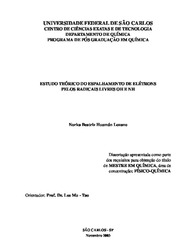| dc.contributor.author | Lozano, Norka Beatriz Huamán | |
| dc.date.accessioned | 2016-06-02T20:36:58Z | |
| dc.date.available | 2004-11-12 | |
| dc.date.available | 2016-06-02T20:36:58Z | |
| dc.date.issued | 2003-11-28 | |
| dc.identifier.citation | LOZANO, Norka Beatriz Huamán. Theoretical study about the scattering of electrons by free radicals OH and NH.. 2003. 75 f. Dissertação (Mestrado em Ciências Exatas e da Terra) - Universidade Federal de São Carlos, São Carlos, 2003. | por |
| dc.identifier.uri | https://repositorio.ufscar.br/handle/ufscar/6626 | |
| dc.description.abstract | Recently, interest on studies of electron scattering by highly-reactive free radicals has grown mostly because their participation on many important processes in several fields such astrophysics, biological and earth s atmospheric studies, as well as in industrial applications. In this work, we report a theoretical study on
electron collisions on two radicals, OH and NH. More specifically, calculated elastic differential, integral and momentum-transfer cross sections as well as total (elastic + inelastic) and total absorption cross sections in a wide incident energy range are reported. The main motivation of the present work is to fill partially the existent lacuna in the literatura for electron-radical interactions, since both theoretical and experimental data for such interactions are rare. It is also known that the experimental determination of electron-radical scattering cross sections are very difficult due
to the high reactivity of these species. The present work covers incident energies in the (0.5-500.0)-eV range. A complex optical potential is used to describe the dynamics of electron-radical interaction whereas a combination of the Schwinger variational iterative method and the
distorted-wave approximation is used to solve the Lippmann-Schwinger scattering equation. Our calculated results are compared with a few theoretical and experimental data for total ionization cross sections, available in the literature for these radicals. Comparison is also made with the results obtained from electron scattering by the molecules H2O e NH3, which are formed by the same chemical elements of
the radicals. Several interesting points are observed in the comparison. | eng |
| dc.description.sponsorship | | |
| dc.format | application/pdf | por |
| dc.language | por | por |
| dc.publisher | Universidade Federal de São Carlos | por |
| dc.rights | Acesso Aberto | por |
| dc.subject | Físico-química | por |
| dc.subject | Radicais livres | por |
| dc.subject | Espalhamento de elétrons | por |
| dc.subject | Colisões elétron-molécula | por |
| dc.title | Estudo teórico do espalhamento de elétrons pelos radicais livres OH e NH. | por |
| dc.title.alternative | Theoretical study about the scattering of electrons by free radicals OH and NH. | eng |
| dc.type | Dissertação | por |
| dc.contributor.advisor1 | Tao, Lee Mu | |
| dc.contributor.advisor1Lattes | http://genos.cnpq.br:12010/dwlattes/owa/prc_imp_cv_int?f_cod=K4783221H9 | por |
| dc.description.resumo | Os estudos das colisões elétron-radicais livres, espécies altamente reativas, tem crescido recentemente, em vista de sua importante participação em muitos processos astrofísicos, atmosféricos, biológicos e industriais. Neste trabalho, foram calculadas as seções de choque diferenciais, integrais e de transferência de momento para o espalhamento elástico de elétrons pelos radicais livres OH e NH. Também foram calculadas as seções de choque total (elástica + inelástica) para estas colisões. A principal motivação de nosso trabalho se deve à falta de dados tanto teóricos quanto experimentais para estas interações. A determinação experimental de tais dados é muito difícil devido à alta reatividade destes radicais. Este estudo visa preencher em parte a grande lacuna existente na literatura sobre o espalhamento de elétrons por espécies radicalares. Neste trabalho, a faixa de energia em estudo incluiu as regiões de energia baixa e intermediária situada entre 0,5 a 500,0 eV. Um potencial ótico complexo foi utilizado para representar a dinâmica de interação elétron-radical. Para resolver as equações de espalhamento foi utilizado o método variacional de Schwinger iterativo combinado com aproximações de ondas distorcidas. As comparações foram feitas com
os escassos dados teóricos e experimentais para estes radicais e também com as moléculas mais estáveis, formadas pelos mesmos elementos químicos (H2O e NH3).
Essas comparações resultaram em informações interessantes sobre os efeitos predominantes
nos espalhamentos por estes alvos. | por |
| dc.publisher.country | BR | por |
| dc.publisher.initials | UFSCar | por |
| dc.publisher.program | Programa de Pós-Graduação em Química - PPGQ | por |
| dc.subject.cnpq | NAO CATEGORIZADO | por |
| dc.contributor.authorlattes | http://genos.cnpq.br:12010/dwlattes/owa/prc_imp_cv_int?f_cod=K4703696A4 | por |
